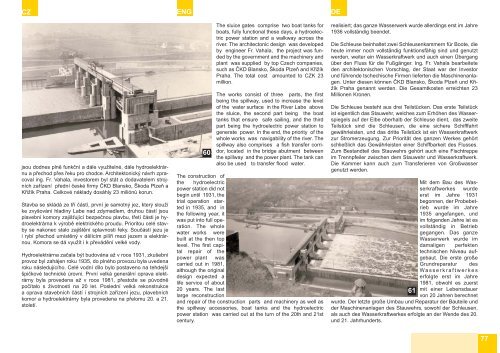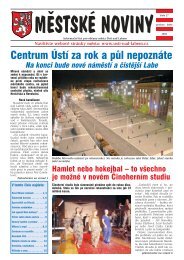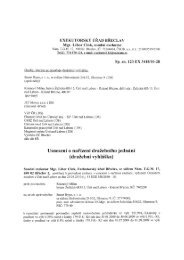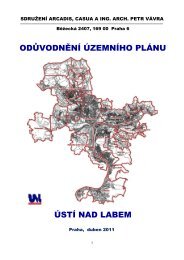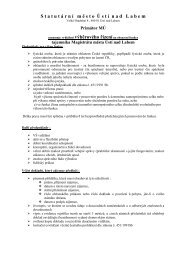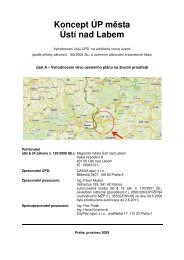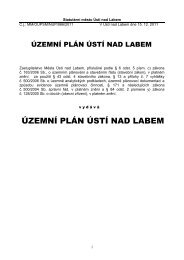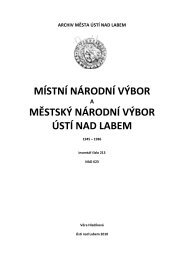Historie a památky města Ústí nad Labem History and monuments of ...
Historie a památky města Ústí nad Labem History and monuments of ...
Historie a památky města Ústí nad Labem History and monuments of ...
Sie wollen auch ein ePaper? Erhöhen Sie die Reichweite Ihrer Titel.
YUMPU macht aus Druck-PDFs automatisch weboptimierte ePaper, die Google liebt.
CZ ENG DE<br />
jsou dodnes plně funkční a dále využitelné, dále hydroelektrárnu<br />
a přechod přes řeku pro chodce. Architektonický návrh zpracoval<br />
ing. Fr. Vahala, investorem byl stát a dodavatelem strojních<br />
zařízení přední české firmy ČKD Blansko, Škoda Plzeň a<br />
Křižík Praha. Celkové náklady dosáhly 23 miliónů korun.<br />
Stavba se skládá ze tří částí, první je samotný jez, který slouží<br />
ke zvyšování hladiny Labe <strong>nad</strong> zdymadlem, druhou částí jsou<br />
plavební komory zajišťující bezpečnou plavbu, třetí části je hydroelektrárna<br />
k výrobě elektrického proudu. Prioritou celé stavby<br />
se nakonec stalo zajištění splavnosti řeky. Součástí jezu je<br />
i rybí přechod umístěný v dělícím pilíři mezi jezem a elektrárnou.<br />
Komora se dá využít i k převádění velké vody.<br />
Hydroelektrárna začala být budována až v roce 1931, zkušební<br />
provoz byl zahájen roku 1935, do plného provozu byla uvedena<br />
roku následujícího. Celé vodní dílo bylo postaveno na tehdejší<br />
špičkové technické úrovni. První velká generální oprava elektrárny<br />
byla provedena až v roce 1981, přestože se původně<br />
počítalo s životností na 20 let. Poslední velká rekonstrukce<br />
a oprava stavebních částí i strojních zařízení jezu, plavebních<br />
komor a hydroelektrárny byla provedena na přelomu 20. a 21.<br />
století.<br />
60<br />
The sluice gates comprise two boat tanks for<br />
boats, fully functional these days, a hydroelectric<br />
power station <strong>and</strong> a walkway across the<br />
river. The architectonic design was developed<br />
by engineer Fr. Vahala, the project was funded<br />
by the government <strong>and</strong> the machinery <strong>and</strong><br />
plant was supplied by top Czech companies,<br />
such as ČKD Blansko, Škoda Plzeň <strong>and</strong> Křižík<br />
Praha. The total cost amounted to CZK 23<br />
million.<br />
The works consist <strong>of</strong> three parts, the first<br />
being the spillway, used to increase the level<br />
<strong>of</strong> the water surface in the River Labe above<br />
the sluice, the second part being the boat<br />
tanks that ensure safe sailing, <strong>and</strong> the third<br />
part being the hydroelectric power station to<br />
generate power. In the end, the priority <strong>of</strong> the<br />
whole works was navigability <strong>of</strong> the river. The<br />
spillway also comprises a fish transfer corridor,<br />
located in the bridge abutment between<br />
the spillway <strong>and</strong> the power plant. The tank can<br />
also be used to transfer flood water.<br />
The construction <strong>of</strong><br />
the hydroelectric<br />
power station did not<br />
begin until 1931, the<br />
trial operation started<br />
in 1935, <strong>and</strong> in<br />
the following year, it<br />
was put into full operation.<br />
The whole<br />
water works were<br />
built at the then top<br />
level. The first capital<br />
repair <strong>of</strong> the<br />
power plant was<br />
carried out in 1981,<br />
although the original<br />
design expected a<br />
life service <strong>of</strong> about<br />
20 years. The last<br />
large reconstruction<br />
<strong>and</strong> repair <strong>of</strong> the construction parts <strong>and</strong> machinery as well as<br />
the spillway accessories, boat tanks <strong>and</strong> the hydroelectric<br />
power station was carried out at the turn <strong>of</strong> the 20th <strong>and</strong> 21st<br />
century.<br />
realisiert; das ganze Wasserwerk wurde allerdings erst im Jahre<br />
1936 vollständig beendet.<br />
Die Schleuse beinhaltet zwei Schleusenkammern für Boote, die<br />
heute immer noch vollständig funktionsfähig sind und genutzt<br />
werden, weiter ein Wasserkraftwerk und auch einen Übergang<br />
über den Fluss für die Fußgänger. Ing. Fr. Vahala bearbeitete<br />
den architektonischen Vorschlag, der Staat war der Investor<br />
und führende tschechische Firmen lieferten die Maschinenanlagen.<br />
Unter diesen können ČKD Blansko, Škoda Plzeň und Křižík<br />
Praha genannt werden. Die Gesamtkosten erreichten 23<br />
Millionen Kronen.<br />
Die Schleuse besteht aus drei Teilstücken. Das erste Teilstück<br />
ist eigentlich das Stauwehr, welches zum Erhöhen des Wasserspiegels<br />
auf der Elbe oberhalb der Schleuse dient, das zweite<br />
Teilstück sind die Schleusen, die eine sichere Schifffahrt<br />
gewährleisten, und das dritte Teilstück ist ein Wasserkraftwerk<br />
zur Stromerzeugung. Zur Priorität des ganzen Werkes gehört<br />
schließlich das Gewährleisten einer Schiffbarkeit des Flusses.<br />
Zum Best<strong>and</strong>teil des Stauwehrs gehört auch eine Fischtreppe<br />
im Trennpfeiler zwischen dem Stauwehr und Wasserkraftwerk.<br />
Die Kammer kann auch zum Transferieren von Großwasser<br />
genutzt werden.<br />
Mit dem Bau des Wasserkraftwerkes<br />
wurde<br />
erst im Jahre 1931<br />
begonnen, der Probebetrieb<br />
wurde im Jahre<br />
1935 angefangen, und<br />
im folgenden Jahre ist es<br />
vollständig in Betrieb<br />
gegangen. Das ganze<br />
Wasserwerk wurde im<br />
damaligen perfekten<br />
technischen Niveau aufgebaut.<br />
Die erste große<br />
Grundreparatur des<br />
Wasserkraftwerkes<br />
erfolgte erst im Jahre<br />
1981, obwohl es zuerst<br />
61<br />
mit einer Lebensdauer<br />
von 20 Jahren berechnet<br />
wurde. Der letzte große Umbau und Reparatur der Bauteile und<br />
der Maschinenanlagen des Stauwehrs, sowohl der Schleusen,<br />
als auch des Wasserkraftwerkes erfolgte an der Wende des 20.<br />
und 21. Jahrhunderts.<br />
77


